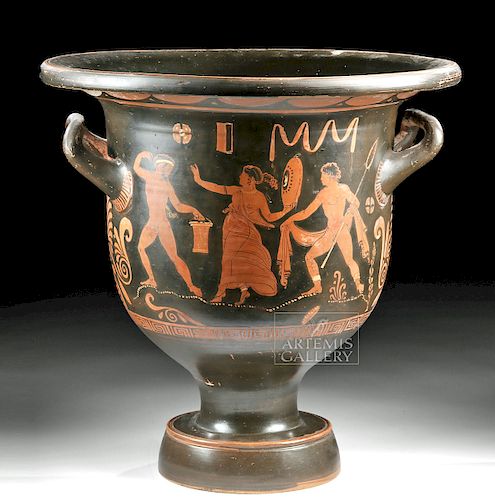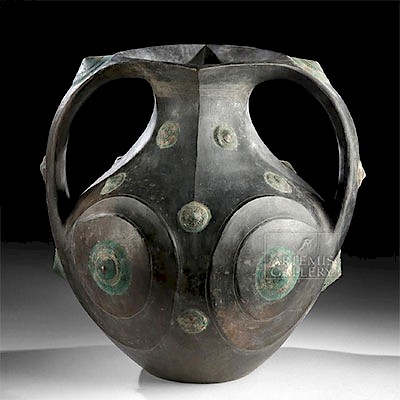Apulian Red-Figure Bell Krater w/ Dionysian Scene, TL'd
Lot 28
About Seller
Artemis Fine Arts
686 S Taylor Ave, Ste 106
Louisville, CO 80027
United States
Selling antiquities, ancient and ethnographic art online since 1993, Artemis Gallery specializes in Classical Antiquities (Egyptian, Greek, Roman, Near Eastern), Asian, Pre-Columbian, African / Tribal / Oceanographic art. Our extensive inventory includes pottery, stone, metal, wood, glass and textil...Read more
Estimate:
$12,500 - $17,500
Absentee vs Live bid
Two ways to bid:
- Leave a max absentee bid and the platform will bid on your behalf up to your maximum bid during the live auction.
- Bid live during the auction and your bids will be submitted real-time to the auctioneer.
Bid Increments
| Price | Bid Increment |
|---|---|
| $0 | $25 |
| $300 | $50 |
| $1,000 | $100 |
| $2,000 | $250 |
| $5,000 | $500 |
| $10,000 | $1,000 |
| $20,000 | $2,500 |
| $50,000 | $5,000 |
| $100,000 | $10,000 |
| $200,000 | $20,000 |
About Auction
By Artemis Fine Arts
Jul 11, 2019
Set Reminder
2019-07-11 10:00:00
2019-07-11 10:00:00
America/New_York
Bidsquare
Bidsquare : Ancient / Ethnographic / Americana
https://www.bidsquare.com/auctions/artemis-gallery/ancient-ethnographic-americana-4246
Discover ancient art from Egypt, Greece, Italy, and the Near East, as well as Asian, Pre-Columbian, Tribal, Fossils and Fine Art. Also featuring a wonderful collection from a prominent New York estate whose owners reside in the Van Wyck family's historic Lloyd Harbor waterfront home. Artemis Fine Arts info@artemisgallery.com
Discover ancient art from Egypt, Greece, Italy, and the Near East, as well as Asian, Pre-Columbian, Tribal, Fossils and Fine Art. Also featuring a wonderful collection from a prominent New York estate whose owners reside in the Van Wyck family's historic Lloyd Harbor waterfront home. Artemis Fine Arts info@artemisgallery.com
- Lot Description
Magna Graecia, Southern Italy, Apulia, ca. 350 to 300 BCE. An enormous Apulian bell krater (wine mixing vessel), its generous surface area extensively painted via the red-figure technique with added fugitive white and yellow pigment - featuring Dionysian (Bacchic) scenes, quite apropos for this wine-drinking vessel. Side A presents a feminine maenad, draped in a diaphanous garment pinned on one shoulder and revealing the other breast, also bedecked with armlets and anklets, and presenting an attractive swept up coiffure. She stands in composite profile holding her right arm outward in protest of a dancing Satyr's advances, with a ribboned tambour in her left before the warrior behind. The Satyr stands in composite profile, facing the maenad and holding a situla in his left hand - the details of his anatomy, facial features, goat ears, and flowing tail skillfully delineated with fine-line brushwork. Size: 17.625" in diameter x 17.625" H (44.8 cm x 44.8 cm)
The warrior is also presented in composite profile, his muscular body in the nude but holding a voluminous cloak in his right extended hand, behind his buttocks, and over the crook of his left elbow. In his left hand he wields a pine-tipped thyrsus (an attribute of cult followers of orgiastic Dionysian cults). Tendrils of foliage, dotted passages, an undulating filet, rosettes, and a cask occupy the field. Side B features two cloaked male youths facing a cloaked female - all of whom hold walking sticks - with a filet above the female. Added/fugitive white and yellow pigments embellish the details throughout.
In addition to this figural iconography, the decorative program is quite impressive, featuring stylized composite palmettes beneath each handle, frets surrounding the handle terminals, a grand laurel leaf garland adorning the underside of the rim, and a register of Greek key (meander) with periodic dotted "X" motifs below the figural scenes and palmettes.
Perhaps the most exciting innovation in Greek vase painting was the red-figure technique, invented in Athens around 525 BCE and beloved by other artists of Magna Graecia. The red-figure technique allowed for much greater flexibility as opposed to the black-figure technique, for now the artist could use a soft, pliable brush rather than a rigid metal graver to delineate interior details, play with the thickness of the lines, as well as build up or dilute glazes to create chromatic effects. The painter would create figures by outlining them in the natural red of the vase, and then enrich these figural forms with black lines to suggest volume, at times perspectival depth, and movement, bringing those silhouettes and their environs to life. Beyond this, fugitive pigments made it possible for the artist to create additional layers of interest and detail as we see in this example.
This piece has been tested using thermoluminescence (TL) analysis and has been found to be ancient and of the period stated. A full report will accompany purchase.
Provenance: ex-private Texas, USA collection; ex-private French collection, acquired before 1925
All items legal to buy/sell under U.S. Statute covering cultural patrimony Code 2600, CHAPTER 14, and are guaranteed to be as described or your money back.
A Certificate of Authenticity will accompany all winning bids.
We ship worldwide and handle all shipping in-house for your convenience.
#147164Minute TL holes under rim and base. A stable crack in the center of the base and a stable crack above the base. Expected surface wear with minor scuffs and areas of pigment loss, though much of the pigment remains and the imagery is quite vivid. Overall, a very impressive example with a strong red-figure iconographic and decorative program.Condition
- Shipping Info
-
All shipping is handled in-house for your convenience. Your invoice from Artemis Gallery will include shipping calculation instructions. If in doubt, please inquire BEFORE bidding for estimated shipping costs for individual items.
-
- Buyer's Premium



 EUR
EUR CAD
CAD AUD
AUD GBP
GBP MXN
MXN HKD
HKD CNY
CNY MYR
MYR SEK
SEK SGD
SGD CHF
CHF THB
THB

















